[BBC Micro, Molimerx]
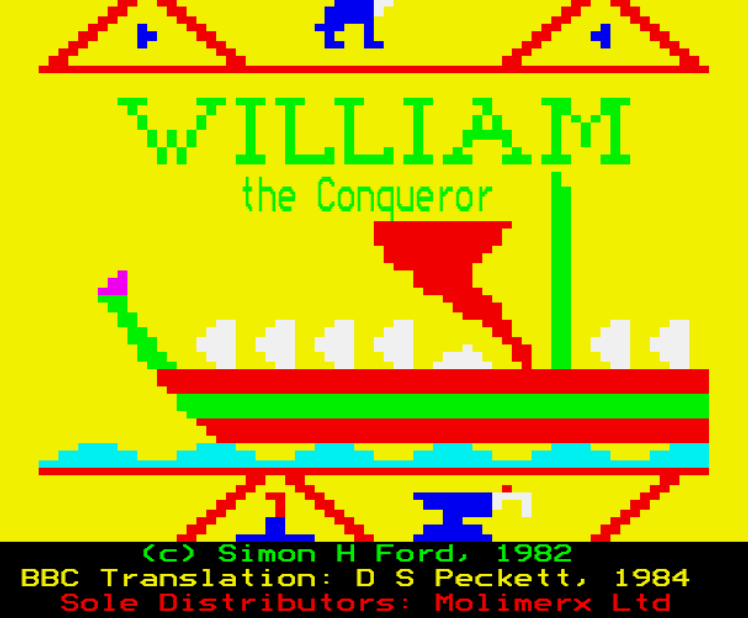
William the Conqueror may be one of the most sociopathic maniacs in French history, but the French love him: he is that one Frenchman (sorta, retroactively, by modern standards) who succeeded in conquering England. While the Conquest itself was a string of lucky rolls for William, he had prepared his whole life for it, and the game allows us to restart his life in 1047, immediately after the Battle of Val-ès-Dunes, as William asserts for the first time some degree of control on his domain.
The map of William the Conqueror is divided into 33 domains covering all of Northern France, Flanders included. England is “off-map” and has its own ruleset, but I have roughly 20 years before it starts to matter.
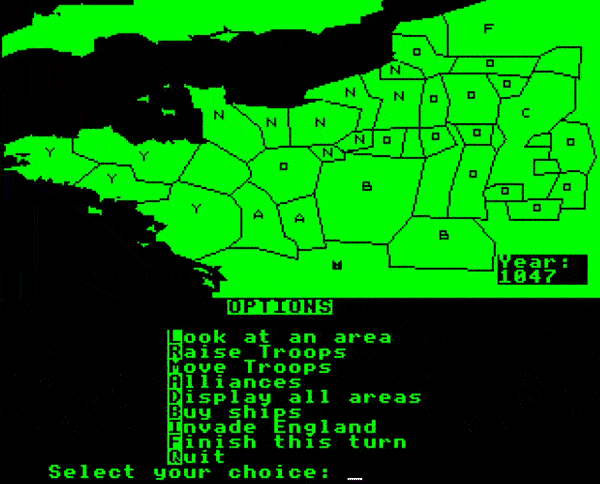
You would think that as a Frenchman I would know the name of those domains, but you need to consider that I am a Parisian, so this is all Province to me. All actions in the game require you to type the first letters of the name of the location you want to interact with, and calling the list above is the only way to see the complete list, so I created this helper to quickly navigate the game:
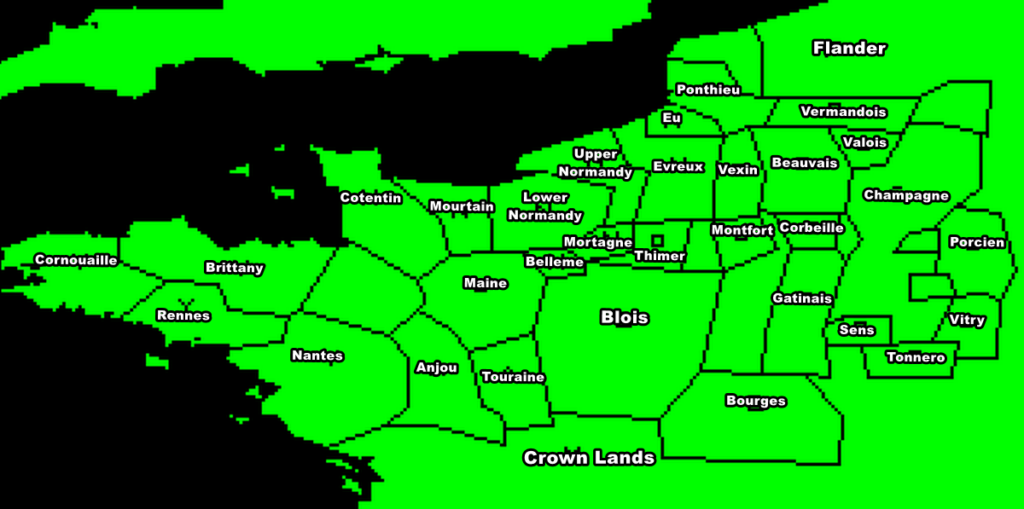
William’s life, even before the Conquest, was marred with rival claimants, betrayals, ambushes, wanton violence, assassinations or attempts thereof. You would think that William the Conqueror would be about beating-the-odds but instead, everything seems stacked in William’s favour.
- Uncharacteristically for a game of this genre, William starts with the largest domain by far – 8 provinces. Each province in the game generates 1000 gold by turn if it is not under siege, so the Duchy of Normandy is a cash machine – which is critical to win the game as an army of 1000 soldiers costs 3000 gold to recruit and 1000 gold by year [turn] – though I don’t think the other factions pay any maintenance.
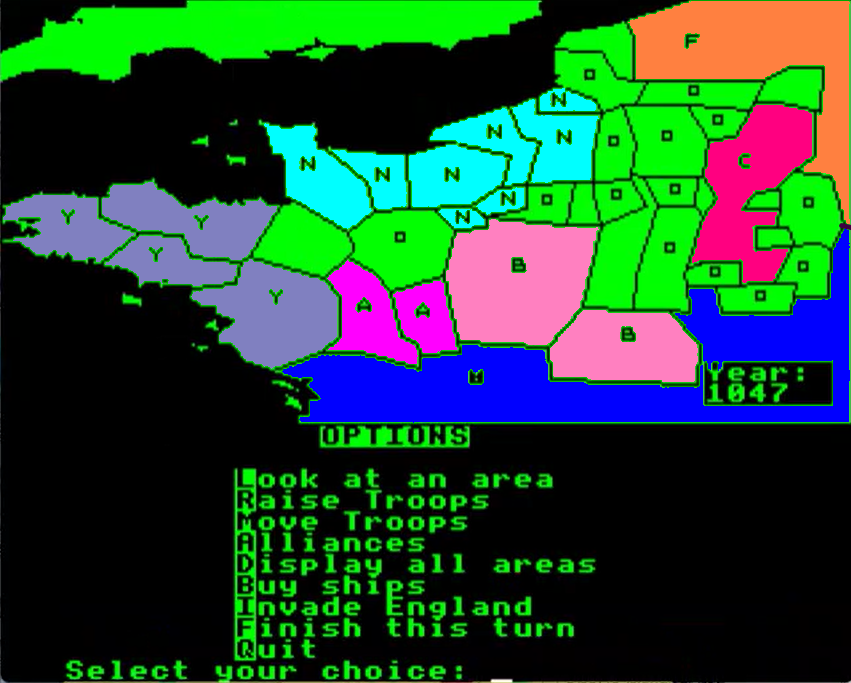
- William started my session with an alliance with France – a powerful faction only rivaled by Flanders and Normandy at the start of the campaign.

This was luck and not design, but I was also blessed by a donation from Henry I of France, no-strings-attached, at the end of 1047. I started with no army in 1047, but with this donation I could field 6000 men in 1048!

Granted, I could have invested that cash in “buying” more alliances, but Baldwin of Flanders told me the price of his friendship was 6000 gold, so I passed on the opportunity.
- The many rebels in the Duchy of Normandy have no impulse control and never attended Strategy 101: they reveal themselves at the end of every turn even though they have no chance of success. They appear in groups of 1000 men even though they would need at least 3000 men to have any chance of succeeding.
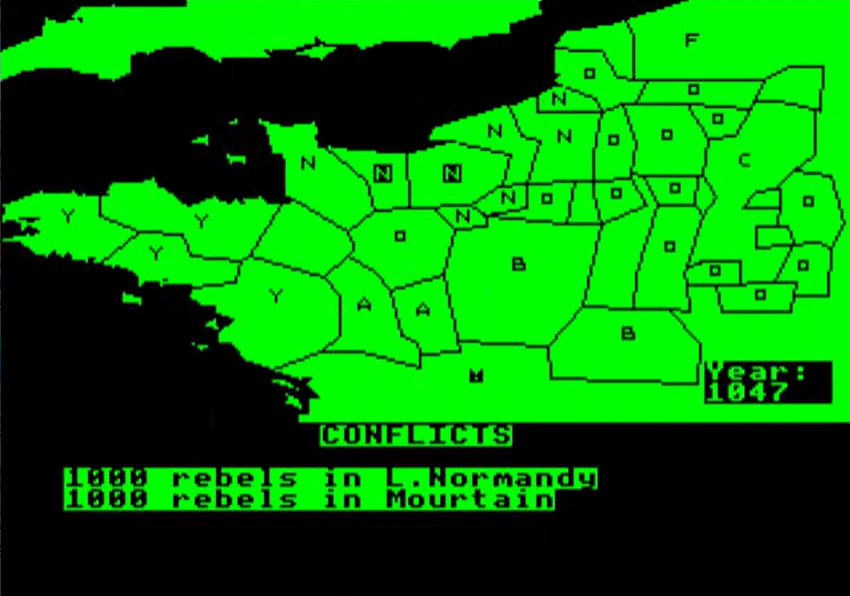
In William The Conqueror, battles are all-or-nothing. An army fully destroys another without any losses on its side if its number is superior by at least 2000 men, else no one dies! Castles count for 1000 men, but defensively only (they can’t “destroy” armies, but can prevent your army from losing) and all domains have at least one castle. It is therefore trivially easy for me to quell the two starting rebellions with my 6000 men.
- East of Normandy, there are many “neutral” domains only defended by one castle each. Starting in 1050, I detach 3000 men and start conquering them one after the other. Knowing William, he probably yelled at and threatened and punched his clerks until they returned with some long-lost addendum to the Treaty of Saint-Clair-sur Epte explaining that everything East of Normandy is, in fact, also Normandy. The ink was still fresh, a proof of the miraculous nature of the discovery.
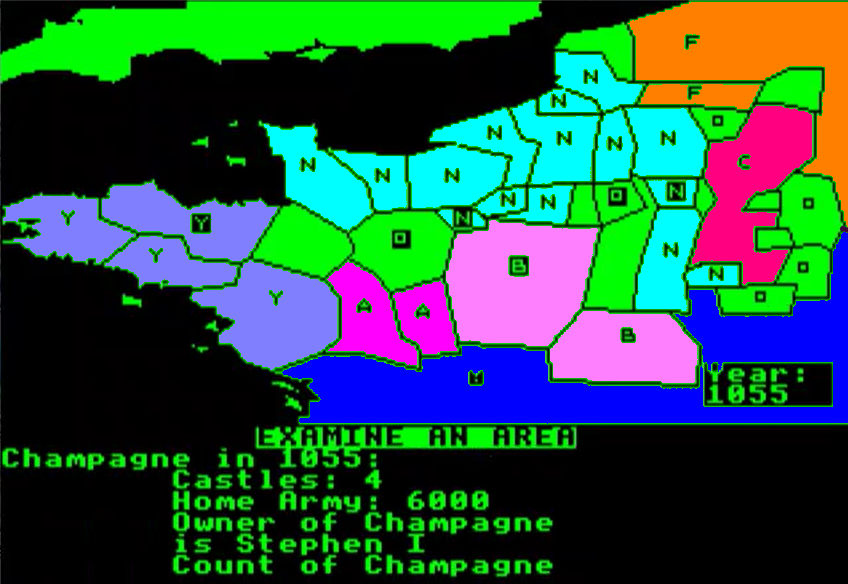
- William plays last, and has perfect information. Shortly after I attack the Count of Blois, because Bishop Lanfranc had a miraculous dream where a dove told him that William was its rightful ruler, I find myself attacked by both Flanders and my “ally” the King of France:
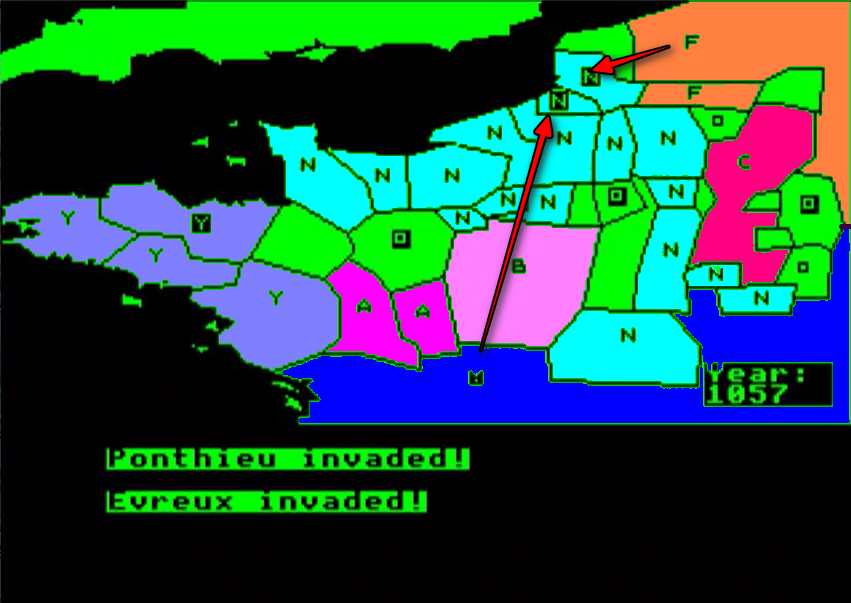
Unfortunately for them, William the Conqueror is a game with perfect clairvoyance, William’s armies move before the sieges are resolved, and I had realized a few turns earlier that they could also move as often as needed during a turn. This means I can teleport my troops where I need them the most!
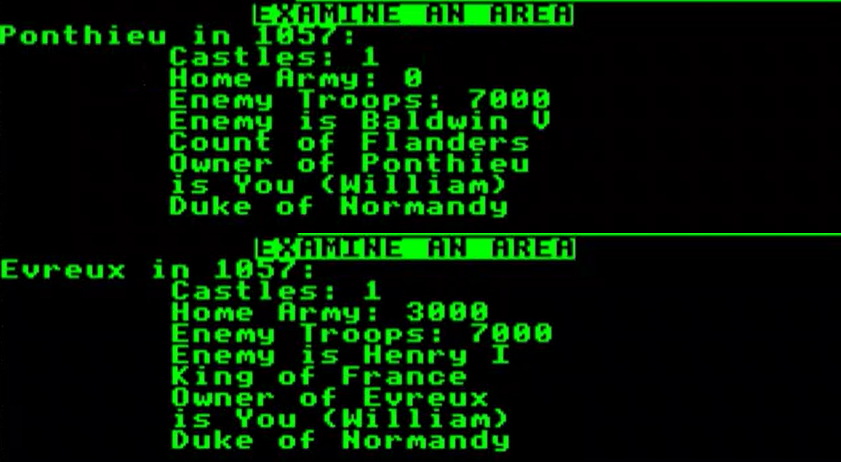
I don’t have enough soldiers to win both battles in the same turn, but I have enough to defeat the force in Ponthieu while stalemating the one in Evreux, and by 1059 both France and Flanders have lost their armies and are militarily non-entities.
My own army is pristine, and I launch the final mop-up with an army that soon soars to 20 000 men. In 1060, William’s clerks discover with shock and horror that the Bishop who witnessed the Count of Champagne’s investiture did not have a real pallium. It’s only a pallium if it comes from the pallium region in Italy, otherwise it’s just a blessed mantle, and it’s not good enough. The investiture was void and William has to occupy Champagne to make things right. In 1062, Bishop Lanfranc finds out that the historical boundaries of Flanders were a 5×5-foot dungeon under the castle of Gravensteen – everything else was part of the historical Duchy of Normandy after all.
In 1069, almost all of Northern France is under William’s control, with the only region still independent being the Crown Lands (they can’t be entered by William’s force) and various domains under rebellion: the game cannot manage three factions in the same location, so I need to wait for the rebellion to end one way or the other before moving my own armies in!
That’s when the big news hits:
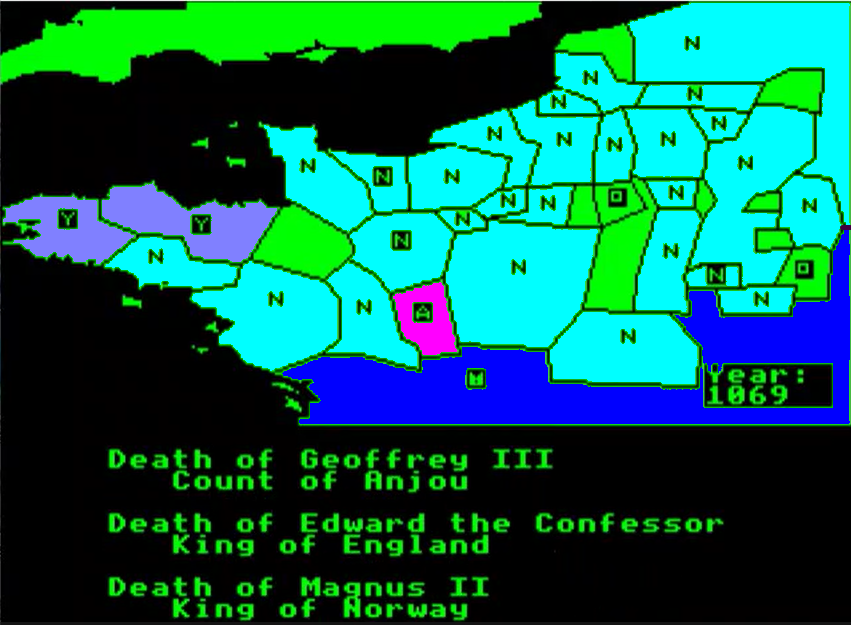
Edward the Confessor has died, and back in 1050 or so he had made William his heir to the Kingdom of England. Granted, there was no witness, but William remembers it very clearly: Edward was sitting near the fireplace and then he said “You know William, when I die in the late 60s, I would like you to be the next king of England. You, and certainly not Harold, the son of Godwin, the current Earl of Wessex.” It is a sorry state of affairs when people don’t trust the word of powerful nobles. Yes, – that’s the real pretext used by William to cross the Channel and conquer England.
So, well, time to Conquer. I had started in the mid-60s to build a significant fleet, but it was not large enough yet in 1069. After a few more years building ships and quelling rebellions, I finally depart in 1076:
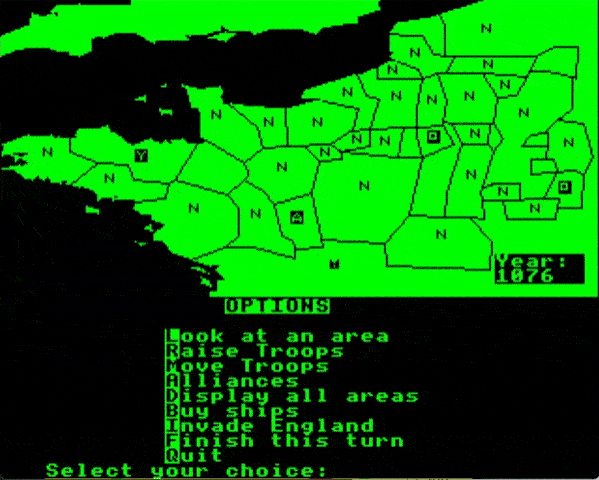
Victory! I have fulfilled my destiny! But I still have quite a few years to live, which are going to be spent waiting for the 4 remaining French domains not under my control to stop their rebellions so I can properly invade them. Patience is not William’s forte but I guess there is some harrying to do off-map while waiting because all my soldiers sent to England disappeared – I have to rebuild my French army from scratch.
Alas, I will never see the end of the game. In 1077, I make the mistake of typing the “Move Army” command when I have no army to move (armies quelling rebels are unavailable):
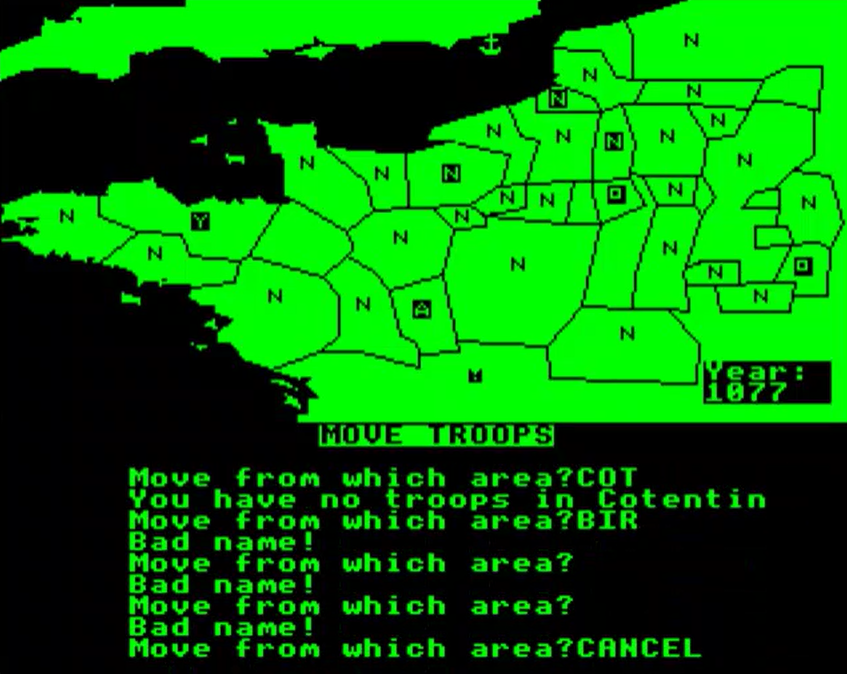
There is no way to exit this menu, and I cannot finish the game.
Luckily enough, commenter WhatHoSnorkers finished the game, and could send me the victory screen:
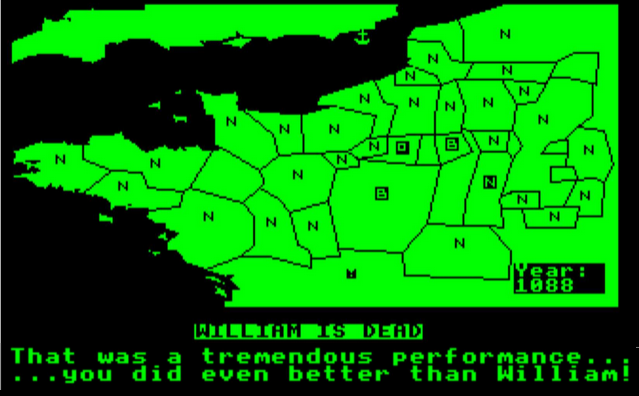
Honestly, I don’t think winning this game deserves that much praise!
Ratings & Reviews
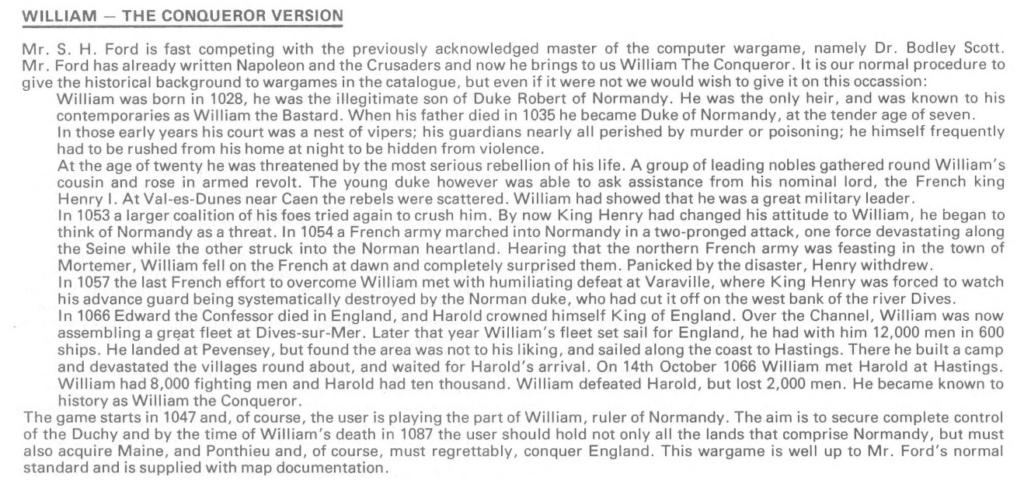
William the Conqueror by Simon Ford, published by Molimerx, UK
First release : 1982 on TRS-80
Average duration of a campaign : 1 hour
Total time played : 1 hour
Complexity: Low (1/5)
Final Rating: Totally obsolete
Ranking at the time of review: 108/126
William the Conqueror is the third and last game by Simon Ford, the mysterious designer to which we owe Napoleon, a particularly mediocre game for the TRS-80 and the BBC Micro. I had skipped William the Conqueror because I did not have the manual, but commenter and streamer WhatHoSnorkers managed to reconstruct a manual of sorts based on the source code!
I am extremely grateful for this initiative, and it was a lot of effort from WhatHoSnorkers for a game that, ultimately, does not seem to have warranted it. On the other hand, the only version that survived is the BBC Micro port, a version coded by D.S. Peckett who has a history of sub-par porting (he made Napoleon even worse than the base game, and added a major map issue in Richard Bodley-Scott’s Emperor), so it is possible that the original version of William the Conqueror was a bit better.
I rate William the Conqueror Terrible in everything, except in Presentation which I “only” rate Very poor because I want to give extra points for the original theme. I particularly note the asinine ruleset, with the combination of perfect information, infinite movement, deterministic combat and winner-takes-all, deprives the game of all choices: either you’ll win and you should attack, or you’ll lose and you should not attack. As for the UI, I don’t know how Ford (or possibly Peckett) thought it acceptable to force you to type all the steps in a movement (“move from where?” “Ponthieu” “To where?” “Eu” “How many?” “5000”. “Another move?” “Y”. “Move from where? “Eu” “To where?” “Evreux” “How many” “5000”. “Another move?”) instead of just the starting province and the destination. The passive-but-cheating AI is the cherry on top of this cake of disappointment. The game is Totally obsolete, and stands exactly on the thin line separating games that are pointless and games that are actively painful to play. I am not looking forward to anyone finding (or rewriting) the manual of Ford’s last game: Crusaders. Should it happen, I will play it nonetheless. But again, please don’t.
Next article will return to War in Russia, whose dry but effective UI suddenly feels so much better!